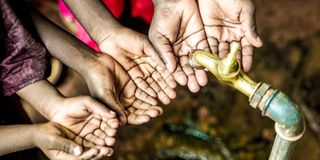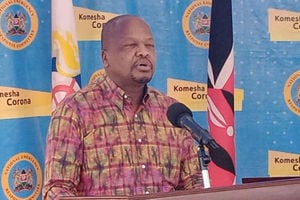What should you do when your child gets burn injuries? The best tips, explained

What you need to know:
- The most common burns in children are caused by thermal or heat burns.
- A study at the Kenyatta National Hospital in 2006 found that, out of the 109 consecutive burn patients admitted, the mean age was 14.4.
- Low levels of education, use of kerosene for cooking, and lack of knowledge of burn injury prevention and fire safety are the leading causes of burns among all age groups.
Children and toddlers are susceptible to burns due to their curious nature and their sensitive skins. In Kenya, the largest number of burns occurs in children.
A study at the Kenyatta National Hospital in 2006 found that, out of the 109 consecutive burn patients admitted, the mean age was 14.4. Children under the age of five had 48.6 per cent more scalds compared to adults. This is echoed by a World Health Organization report which says that along with adult women, children are particularly vulnerable to burns.
“Burns are the fifth most common cause of non-fatal childhood injuries,” the report says. A related study that was conducted at the KNH in 2018, identified low levels of education, use of kerosene for cooking and lack of knowledge of burn injury prevention and fire safety as the leading causes of burns among all age groups. In children, though, the WHO identifies lack of adult supervision as the leading cause of burn injuries. “While a major risk for burns in children is improper adult supervision, a significant number of burn injuries in kids is also from child maltreatment.”
According to pediatrician Dr. Benson Karanja, the most common burns in children are caused by thermal or heat burns. “Thermal injuries in children are often caused by scalds from hot fluids – such as a cup of porridge – and are predominantly seen in children under the age of 3,” he says. Hot on their heels are the contact burns. In most cases, the injuries sustained are on the palms of the child’s hands. “For instance, the child comes into contact with a hot object, a heater or hot frying pan.” Eighty percent of burns in children occur at home.
Esther Kariuki, a psychologist and Lead Consultant at ICPS, notes that boys usually suffer more burns than girls. Additionally, she says child burns are grouped into four categories depending on the extent of the injuries sustained.
First-Degree Burns: They include mild burns that only affect the top layer of skin. The skin becomes red, pain is experienced and a minor swelling develops. The skin is dry without blisters.
Second Degree Burns: They are more serious and affect more layers of the skin. The burns produce blisters, severe pain, and redness. The blisters sometimes break open and the affected area swells.
Third Degree Burns: They involve all the layers of the skin and the underlying tissues. The surface appears dry, waxy white, leathery, brown, or charred. There may be little or no pain, or the area may feel numb because of nerve damage.
Fourth Degree Burns. They are very rare but lethal, and the burns extend to muscle and/or bone.
According to Dr. Karanja, treatment and care for a child with burn injuries is divided into phases. “The care may include rescue, resuscitation, resurfacing, rehabilitation, reconstruction and reviewing.” These are especially critical where a large portion of the child’s skin has been destroyed.
Treatment and Home Care
All burns should be treated quickly and appropriately to reduce damage on the skin and the underlying tissues. According to Dr. Karanja, a superficial burn will heal within 7-12 days. “At 14 days after the injury has occurred, any unhealed areas greater than 2.5 cm² that have no islands of epithelium should be assessed for skin grafting.”
Thermal burns: If your child suffers a thermal burn, quickly immerse the burned hands, arms or legs in cool water. You can also expose the burned area to running tap water or cover it with a wet, soft cloth. “Continue until the pain on the child has eased, usually for 15-30 minutes.” However, do not apply ice. “Applying ice causes vasoconstriction and increases nerve damage,” cautions Dr. Karanja.
Chemical burns: If your child has suffered a chemical burn, carefully and gently brush off the dried chemical from the skin – with your hands well protected. Then, remove any contaminated clothing. Remember to wash the skin with a lot of water, particularly where the mouth or eyes have been affected. In addition, use the antidote recommended on the product container, or soap.
Electrical burns: Quickly disconnect the power source, or pull the child away from the electric source using a poor conductor of heat such as a wooden spoon or a cushion stool. Do not do it with your bare hands. Have your child evaluated by a doctor since electric burns are not always visible and easily harm interior body parts.
Flame burns: Extinguish the flames by having your child roll on the ground. Cover the child with a blanket or jacket. Remove smoldering clothing around the burned area. However, do not forcefully pull clothing that is stuck on a wound.
Psychological help
In all likelihood, a child who has suffered severe burn injuries may be left with permanent scarring and or suffer from nightmares, sleep problems, behavioural problems and reduced appetite. Esther notes that the child may have difficulty accepting how they look and live with regret. “Such children will require psychological help from both a counsellor and a parent,” she says. Begin by reassuring your child that she will be well irrespective of the accident. “Talk to her and listen to her fears. Remember to explain things according to her level of understanding and age,” says Esther. Be in control. This will give your child a sense of security and hope, particularly where she or he has suffered 3rd or 4th degree burns. Remember to take care of yourself. “Avoid feeling guilty or angry at the loss of the child you had before the accident,” says Esther.
First Aid dos and don’ts
- Don’t apply margarine or any fats, grease or ointment. They will trap heat in the skin.
- Don’t apply baking soda preparations or powder soaks to the burned area.
- Don’t break any blisters that form.
- Cover burns with simple non-adhesive dressing such as Clingfilm.
- Dry the affected area gently but do not use cotton wool as it could get stuck on the wound.
- Keep burnt parts raised e.g. legs above heart level by propping them on pillows or other soft materials to reduce infection.
- Either leave the burn alone or dull it with some aloe vera gel or lavender oil.
- Cover the child with a light blanket or sheet to keep him/her warm and comfortable.
- If the child can take oral fluids, give or breastfeed if not yet weaned. This will help her hydrate and replace the lost water, avoiding further complications like kidney failure.
- When dressing the child, use playful distraction, praises and reassurance to make the process less stressful.


